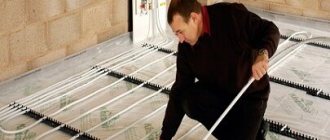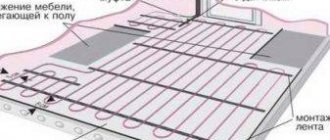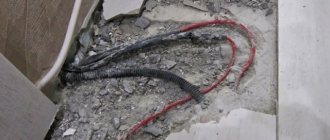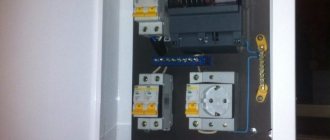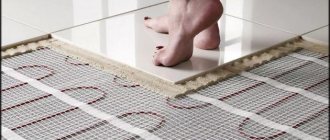The type of heating in which heat is generated by using electrical energy is distinguished by its simple design, and its installation takes a minimum of time. You don’t have to be a professional to install an electric heated floor with your own hands, you just need to follow all the instructions exactly.
The article we presented describes in detail all types of electric underfloor heating systems, their characteristics and pros and cons are given. For do-it-yourselfers, we have provided step-by-step installation guides. Taking into account our advice, you can build and connect an electric floor with your own hands.
Types of heated floors
Electric floors are heating systems that run on electricity. These devices include a thermostat and a temperature sensor.
Such heating evenly warms the surface, does not take up useful space in the house and does not spoil the interior.
The disadvantage of all electric heating models is the risk of electric shock, but only if installed incorrectly.
Cable floors
Cable-type devices include heating cable and heating mats. The wire in such floors is resistive or self-regulating.
The first one can be single or two-core:
- single-core - has one current-carrying core, is cheap, but has high ELM radiation, so it is not suitable for residential premises;
- two-core - two wires united by one insulating shell, the radiation of electromagnetic waves is lower, which is why it is used in living rooms.
The device of the self-regulating cable consists of two current-carrying conductors closed in parallel with a semiconductor matrix. It is able to regulate the heating level itself, depending on the air temperature.
Types of cable heating:
- Heating cable - this type of warm electric floor was one of the first to appear. It has 100% heat transfer, that is, all electricity is converted into heat. The device is a double-insulated wire that heats the surface. It unfolds on the base with a certain step. Installation is the most labor-intensive, because most often this electric floor is laid under a concrete screed, although a laying method is possible. The “pie” consists of: a base, thermal insulation, a substrate, a heating element, a screed and a finishing coating.
- Heating mats differ from cable mats in that the wire is already fixed to the fiberglass film. This makes DIY installation much easier; you just need to roll out the mat, no need to calculate the installation step and fix the heating element. The layers of this electric heated floor are the same as when using heating mats, only instead of a concrete screed, the device can be filled with tile adhesive.
Infrared systems
In this design, heating is carried out by infrared waves, there is no electromagnetic radiation. Objects in the room are heated, not the air in it.
Infrared systems include film floors and rod mats:
- Film flooring is a thermal film with a carbon base. The heating elements consist of an alloy of copper and aluminum, they are located parallel and sealed inside the film, along the edges of which there are conductive busbars. The advantage of such heating is the lightness of the structure, the absence of the need to fill the screed, and the floor covering can be of any kind and can be laid directly on the film. It itself is only 0.3 cm thick, so it does not take up the height of the ceiling. In cross-section, such a floor looks like this: a rough base, foil thermal insulation, heating film, polyethylene and floor covering.
- Rod - mats made of carbon rods placed parallel. Carbon is a nanostructure made from a carbon base with binding components. The standard width of such mats is 0.8 m and the length is 25 meters. Such a device has a self-regulation function. The disadvantages include the possibility of installation only in a screed.
“Pie” of this gender:
- base;
- heat reflecting material;
- carbon mats;
- concrete screed or tile adhesive,
- coating.
Advantages and disadvantages of ETP
The advantages of ETP are:
- ease of installation of the structure.
This is especially true for heating mats and infrared film. They simply need to be laid out on the base and connected according to the instructions; this does not require any special knowledge; Easy to install - high reliability and durability.
Provided the insulation is intact, the heating wire or mats embedded in the screed have an almost unlimited service life; High reliability and durability - high autonomy.
ETP does not require connecting the house to the water supply and even works from an electric generator. This allows it to be used in village houses and cottages. Versatility. These floors can be installed in any room
The disadvantages of this heating method include:
- relatively high cost of heating a room. EHP consumes quite a lot of power, especially if it is the only heating method;
- Due to the relatively low temperature of the floor surface, the air in the room warms up rather slowly. This is relevant if the EHP is the only source of heat and does not operate constantly. For example, in a country house in winter;
- Since heating elements are prohibited from being placed under massive furniture, global rearrangement of the furniture will not be possible after the work is completed.
Do-it-yourself cable heated floor installation technology
Installation of cable heated floors.
It is easier to install an electric heated floor than a water one, but there are some nuances here too. Let's look at step-by-step instructions for installing a cable floor.
Laying scheme
Before installing a warm electric floor, you need to read the installation instructions and draw a diagram on paper. It should be remembered that it does not creep under furniture and appliances. In addition to the fact that this is not rational, it can also lead to overheating of the system and its failure.
There are two main ways to lay floor wires - “snail” and “snake”. When installing the heating element correctly, the distance from the walls should be at least 10 cm.
Calculation of materials
At the next stage, it is necessary to calculate the amount of material that will be needed to install a warm electric floor in the room. To do this, it is better to use ready-made tables that are developed by system manufacturers or special calculators.
The main task is to correctly calculate heat loss. After this, the optimal laying step is determined and the required cable length is calculated. When calculating the length, you must not forget about the section that runs along the wall to the thermostat.
The wire length is calculated using the formula
h=S x100/L , where:
- h - cable length;
- S—area;
- L is the total length of the wire.
In addition, you will need fastenings, a copper grounding cable, connecting wires, an RCD protection system, a regulator and a sensor.
Calculation of power and laying pitch
The required power of the device is influenced by climatic conditions and the material from which the house is made. It is different for different regions, for central Russia it is:
- In the kitchen, hall, hallway - 150 W per m2;
- In the bedroom and children's room - 120 - 150 W;
- In a glazed loggia - 200;
- In the bathroom - 180 W per m2.
In addition, the choice of power depends on the purpose of the system:
- main heating - 140 - 180 W per m2, while covering at least 70% of the area;
- additional - 140 W is enough.
The energy consumption per room is calculated, with the removal of zones where furniture will be placed. That is, only the heated area is taken into account, and not the one indicated in the BTI documents.
Power is calculated by the formula: P1= P2*S*1.3
- P1 - power;
- P2 - heating power m2;
- 1.3 is the coefficient.
The laying step is calculated based on indicators such as:
- Number of linear meters of heating element;
- Heated surface area;
- The coefficient for a given room is W per m2.
Let's consider an example of calculation for a room of 25 m2 - a hall. 5 m2 is filled with furniture, 20 m2 remains for heating. The power indicator for such rooms is 150 W. As a result, a heating element with a power of 3 kW is required.
Cables are regulated by linear power, the range ranges from 12 - 24 W per linear meter. It follows that you can buy 125 or 250 m. This depends on the laying step - the distance between the loops. It is believed that the smaller the step, the more uniform the heating. But at the same time, the more frequently the branches are located, the more difficult and time-consuming the installation will be. The average standard laying step is 7 cm.
Control block
A thermostat is required to control and control the temperature level. He is responsible for turning the floor on and off, as well as for its operating mode.
Thermostats are either electronic or mechanical. According to the recommendation of professionals, the regulator should be installed on the wall, at a distance of one meter from the floor, preferably closer to the electrical wiring. To place it, you need to make a recess in the wall, from which you make grooves for wiring to the floor.
Preparing the base
Laying any electric heated floor, including cable, is possible on a flat, clean surface.
If there is old finishing material, it is dismantled. The floor is cleaned of dirt with a broom or construction vacuum cleaner. Then, the base should be inspected for irregularities and cracks.
If there are minor irregularities, they can simply be rubbed off. If the differences in the base are large, then you will need to pour a thin layer of leveling screed, 3 - 7 cm. Before pouring the self-leveling compound, the surface is primed. Only after the solution has dried can you proceed to the construction of the next layer.
It is possible to install a warm electric floor directly on the floor slabs; they also need to be cleared of debris.
Thermal insulation
Hydro and thermal materials are laid on the subfloor; they are necessary for the efficient operation of the system.
First, a polyethylene film is laid - it will serve as waterproofing. Insulation is spread over it - it can be foam foam with a foil layer. The slabs are placed butted against the walls, the seams are connected with tape. Expanded polystyrene or polypropylene foam is also suitable as thermal insulation.
After this, the perimeter of the entire room is glued with damper tape, this compensates for the expansion of the screed when heated.
To simplify the fixation of the heating element, it is recommended to lay reinforcing mesh on top of the thermal insulation. It will make the structure stronger, and the cable will be attached to it.
Cable laying and fastening
The wire must be laid according to the prepared diagram, with a planned step. Start from the place where the cable will be connected to the thermostat. If a single-core wire is used, then it must also return to the thermostat; when using a two-core wire, this is not required.
If there is fittings, the heating element will be attached to it with plastic clamps. If it is not available, a steel mounting tape is mounted on the thermal insulation, to which the wire will be fixed with dowels or self-tapping screws. Perhaps fastening with mounting tape directly to the insulation boards.
Installing a Temperature Sensor
The temperature sensor is placed on the floor, the distance from it to the wall with the regulator is 1.5 meters. To do this, recesses are made in the thermal insulation for it and the wiring going to the device.
This is necessary so that the sensor does not rise above the surface. It is placed in this recess, placed in a corrugated pipe, which has a plug at one end, and is tightly fixed.
Connection - diagrams
This is the most critical stage on which the performance of the floor depends. The sequence of actions is as follows:
- Checking the wiring - after all, installing an electric floor significantly increases the load on the electrical wiring of the entire house. Using a multimeter, the cross-section of the cable in the network is determined, then it is analyzed whether the wire of the warm electric floor matches it. If the diameter of the cores does not match, it is necessary to change the wiring. An RCD with a circuit breaker is selected for the new load.
- Connecting the device involves connecting the heating cable and the wire from the temperature sensor to the thermostat. After which, the thermostat is connected to power.
- Additional grounding of the cable and power cord.
Before pouring the screed, the device is turned on for a few minutes to check its functionality.
Installation of screed layer
After checking the system, you can install the next layer of the structure. There are several options:
- Pouring wet screed. For this, both ready-made mixtures and it is possible to make the solution yourself. The mixture is made from sand, cement, water, with the obligatory addition of plasticizers. The layer thickness is 3 - 5 cm. The solution is applied from the central corner of the room towards the door. The surface is leveled according to the rule and left for 28 days until completely dry.
- Pouring tile adhesive. The cable is covered with a layer of 5 - 8 cm and left to dry for a while.
- Laying dry screed. For this, fine quartz sand or slag is used. The method is simpler and faster than with concrete mortar. The mixture is distributed over the floor surface; it should cover the structure completely. After 12 o'clock you can begin further work.
Arrangement of the finishing coating
Only after the solution has hardened, according to the instructions, can you proceed to laying the selected topcoat. This could be laminate, linoleum, tile, the main thing is that the product is allowed to be adjacent to heating systems.
Installation of heating cable in grooves
The heating cable can be installed in grooves, but this is a complex process. It is recommended only if there is a clean cement-sand screed, and when it is not possible to raise the floor level yet.
After hollowing out the grooves in the concrete for the wires, the recesses are filled with tile adhesive. Then the cable is pressed into the composition so that there are no air voids.
For uniform heating, with grooves measuring 1 cm, a wire of 10 - 12 W/m is used, with 2 cm - 20 W/m.
Installing a cable on an old base
When installing a heating cable on an old concrete base or tile, the heat loss is 30%.
First, insulation is laid on the floor, then a mounting tape is placed to which the heating element will be attached. Only then, the wire is covered in an even layer with tile adhesive.
Low capital costs
Due to the uselessness of the boiler room, capital costs for all equipment for electric water heated floors should be 2-3 times less. But that's what the advertising brochures say.
In practice, if you add up all the numbers, the picture turns out to be the opposite. Here are the data for a residential building of 100 m2 with a pipe length of 300 m (these are calculations with prices without “electrics”, prices at the beginning of 2022).
If we add here the cost of 11 thermostats + 11 automatic switches + differential circuit breakers or RCDs + copper cable to each circuit + distribution cabinet, you get a figure of about 300 thousand rubles.
With water heated floors for the same initial data, the price will be as follows:
- pipes 360m (with transit) – 40 thousand.
- boiler - 50 thousand
- collector - 23 thousand
- manifold and boiler piping – 20 thousand.
In total, with materials from not the cheapest price category, the amount is 133 thousand rubles.
In fact, an electric water heated floor system will cost you at least 2 times more than the equipment of a conventional heated floor along with a boiler room!
At the same time, do not forget that in addition to heating, the boiler can also be adapted for hot water supply, without which you cannot live in your home.
Installation of thermomat
Installation of Thermo Thermomat
The process of installing heating mats with your own hands is much simpler than cables, since the wire is fixed to the sheet:
- Draw a diagram of the location of the mat on paper; we must remember that they are not placed under heavy furniture.
- The power of the heating device and the amount of material required are calculated - this is done by analogy with cable floors, taking into account the usable area.
- A place on the wall for the temperature sensor is determined, a recess is made for it, as well as grooves from this area to the sensor.
- The base is prepared - it is leveled and cleared of debris. Then it is covered with a primer - this will improve the adhesion of the floor to the solution.
- The sensor is installed - placed in a corrugated pipe and placed at a distance of at least 50 cm from the wall. It should be placed between the floor turns.
- Mats are laid - they are laid directly on the subfloor to avoid overheating; additional insulation is not necessary. The product is equipped with adhesive tape, so no fasteners are required. Mats should not overlap each other. If you need to trim the fabric, you need to be careful not to damage the electrical wire.
- The connection is made and the system is checked - the resistance of the cable in the mats is checked with a multimeter. The thermostat is installed, the floor and sensor wires are connected to it, after which it is connected to the power supply. A test run of the system is performed.
- The mats are poured with tile adhesive - a layer of 8 - 10 mm, and time is given for it to dry. The grooves are also sealed with this composition.
It is possible to lay mats in concrete or dry screed; this process is the same as when installing a heating cable (described above).
- The finishing coating is laid - when filling the mat with glue, it is often tiles.
Turn on the electrical system only after the glue has completely dried.
Thermal mats can be laid on an old base, similar to a heating cable.
Life time
The declared service life of the system is more than 50 years!
A logical question arises: where did this come from and how was it calculated? Most likely, the information was obtained based on the fact that any manufacturer of polymer materials (pipes) automatically provides 50 years of trouble-free operation for its products (subject to operating temperature).
What if there is a liquid leak or a malfunction of the thermostat? And this can easily happen due to a power surge.
What will your pipes turn into after uncontrolled heating?
That is, here initially you need to take into account several factors, and not just the material of manufacture and its factory service life.
Secondly, do not forget that there is a thermal expansion compensator inside the pipe. Who calculated how long he would work?
Thirdly, it is unknown how the chemical composition of the non-freezing liquid will affect the properties of the tube walls. The properties of the antifreeze itself also change over the years.
This means that it will have to be drained and refilled somehow. No one usually tells you about these nuances.
You just have to BELIEVE in the beautiful number 50.
Film floor installation
Infrared heated floor - Installation, laying and connection of film flooring.
As mentioned above, installing a warm electric film floor is simple. But you need to start, as when installing any heated floor, with the film location diagram (do not lay it under furniture). The film is placed at a distance of at least 10 cm from the furniture.
Then the power of the floor is determined. When laying laminate as a finishing coating, the power should not exceed 150 W, if there are tiles - up to 200 W. Afterwards, the quantity of the product is calculated - with film this is easy, it should cover the entire required surface, a maximum length of 8 meters.
The process of constructing an electric heated film floor is similar to cable systems, the only difference is in the arrangement of the heating element.
Preparatory work
You should start by preparing the area for the thermostat. It is installed in an accessible place on the wall. A recess is made for it, in which the junction box is placed.
Then the subfloor is prepared - leveled and cleaned.
A polyethylene film is laid down - it is necessary for protection from moisture. Foil insulation (no more than 5 cm thick) is laid on top of it, with the metallized side up, this will help avoid heat loss. The sheets are glued together with tape.
The location of the film is marked on the insulation, and a recess is made for the sensor. The temperature sensor should be placed under the second section of the infrared floor - this will allow more accurate reception of information about surface heating.
Film editing
Floor strips are laid according to the prepared diagram. To reduce the length of the wire, the film is placed with its end sides to the wall where the thermostat will be, the distance from the wall is 15 cm, the copper contacts should be located down.
Laying the sheets overlapping is not allowed; they must be positioned end to end. If necessary, the film can be cut, but only along specially designed lines; the maximum length is 8 meters. The product is fixed with tape to the heat-insulating material.
Connecting the system
The film is connected to the power supply using terminals. To do this, the insulation is removed from the edge of the wire, it is inserted into a clamp, one contact of which is inserted inside the film, and the second is installed on a copper busbar. All contacts are fixed with pliers and insulated with bitumen tape; the places where the film is cut must also be insulated.
After this, a temperature sensor is installed, it is attached to the bitumen insulation to the black silicon strip at the bottom of the film, and the wire is pulled to the thermostat along a recess in the substrate.
The thermostat is installed. The sex cables from the sensor are connected to it. Then the power supply wire is connected. To check the functionality of the system, you need to turn it on at full power for a few minutes.
Laying the finishing coating
Before laying the finishing product, the structure is covered with thick polyethylene - this will protect it from moisture.
Laminate flooring can be laid directly on plastic film. If you are going to lay carpet or linoleum, then sheets of plywood are placed on top of the waterproofing.
How to properly install tiles on a warm film floor - this can be done in two ways:
- A painting mesh is placed on the polyethylene to improve adhesion. A thin layer (1 cm) of self-leveling compound or screed is poured.
- The waterproofing is sheathed with GVL, the sheets are fixed with self-tapping screws. It is important not to damage the film. The tiles are mounted using underfloor heating adhesive.
Electric film floors can be installed on old flooring.
To do this, it is cleaned, a heat-reflecting product is placed on top, on which the film is laid.
Laying infrared film
Finally, let’s look at how to install infrared-type heated floors.
The installation operation is not particularly difficult, but before installation it is necessary to carry out preparatory work.
It will be necessary to lay a thermal insulation layer on the floor surface. In this case, the layers of thermal insulation are secured to each other with mounting tape.
Next, an infrared film is spread on the surface of the thermal insulation.
If necessary, pieces are cut off; this should be done only in the places indicated on the film.
In this case, a distance of 4-5 cm must be maintained between the two strips of film.
Also, the film does not need to be placed in furniture locations; it should not come close to the walls or other heating elements of the house.
Installation of a core floor
How to make a warm floor under tiles? It's simple. DIY installation!
Technology of laying rod-based heated floors with laying of cable mats. First, a layout is made for the placement of the canvas, and the amount of material required is calculated.
Rod floors are sold as a kit, but sometimes it is necessary to purchase additional components. The required power is calculated by analogy with the cable mats that we discussed above.
Laying a core floor consists of several stages:
- Preparatory work - determining the location for the temperature sensor, cleaning and leveling the base, placing the foil backing - these works are carried out in the same way as when installing any electric floor. If the floor is planned to be screeded, then the perimeter is covered with damper tape.
- Installation of rods - the rod roll unwinds on the surface, the distance between adjacent strips should be 50 - 70 mm. The length of one strip should not exceed 25 m. The strips are fixed to the substrate with tape.
- Connection - a thermostat is installed in the prepared area, to which the floor wires are connected. The sensor, placed in the corrugation, is placed in the groove of the substrate and connected to the regulator, which in turn is connected to the power source. A prerequisite is to conduct a test test of the system before the next stage of work.
- Pouring the screed - this can be concrete mortar, dry adhesive mixtures, or dry screed, layer thickness 20 - 30 cm.
- Installation of the finishing coating - only after the screed has completely dried is the finishing material applied. When laying tiles, no screed is required; the mats are filled with tile adhesive.
It is permissible to lay a core heated floor on an old coating. The installation principle is the same as when installing a thermomat.
Where is it used?
Electric heated floors are successfully used in absolutely any type of premises. These can be apartment or private houses, garages, bathhouses or loggias. It is only important to choose the right power of the system and ensure sufficient thermal insulation. This method can be used as the only source of heating the room. But energy costs can add up significantly.
An example of arranging a heated floor on a balcony
Electric heated floor in a private house
Common Mistakes
How to install electric floors correctly with your own hands - this question often arises for beginners who want to do this heating at home.
The main mistake is installing floors under large furniture. Underneath, the surface is not cooled, which leads to overheating and then failure of the system.
You cannot bend the cable either, as this will disrupt the functioning of the device. When laying cable mats, cutting the wire is unacceptable, so you should correctly calculate the size of the heated area.
A common mistake when constructing electric floors is inappropriate control of the insulation resistance during installation. The indicator should not exceed that specified by the manufacturer by more than 10%.
When using a film heated floor, it may stop heating if the film is damaged. Its current-carrying parts must be properly insulated, otherwise electric current will leak and the system will eventually shut down.
If we talk about the temperature sensor, then you should not pour it into the screed. In case of breakdown, replacement will be difficult. It is placed in a corrugated pipe.
Outline length
A significant disadvantage of the system is the multiple length of the segments. Electric water heated floors can be installed in sections that are multiples of 7 meters (7m-14m-21m, etc.).
At longer lengths, sizes jump within 14 meters! You won't be able to cut a smaller piece.
As a result, you will either have a long “tail” (relevant for small bathrooms and bathrooms), or you will be missing a couple of meters. It all depends on the area of the room.
Don’t expect that you can simply lay the “snake” more tightly. No one has canceled the minimum permissible laying step of 200mm.
Reduce it, overheating, violation of instructions, loss of warranty, etc. will follow.
This problem does not arise with water heated floors. Cut the pipe wherever you want.
Safety requirements for operation
Before using electric floors, read the manufacturer's instructions included in the kit.
Basic safety requirements that apply to all types of electric floors:
- Do not shorten the heating element;
- It is necessary to take only a screed solution or tile adhesive intended for warm polos;
- Opening heat-shrinkable sleeves at the junction of the heating and installation parts of the floor is prohibited;
- Do not lay carpet on heating sections or place furniture without legs.
Thermostats
Thermoregulator (thermostat) is a device designed to control the heating system. Allows each user to control the heating temperature level, reducing or increasing it at will.
In the modern market, accessories of this type are offered in a wide range by various brands. The cost of devices largely depends on the country of origin. The cheapest models are made by China; in the middle price segment, products from Belarusian and Russian enterprises predominate, and the highest prices are asked for products from Danish, Finnish and Swedish brands.
Another cost component is the type of thermoregulatory device. Simple and unpretentious devices with a minimal set of functions will cost the client significantly less than ultra-modern programmable models with an extensive package of capabilities and a memory base that allows you to set the desired heating mode for 3-7 days.
The third pricing factor is the management method. Today, mechanical, wireless, push-button and touch-sensitive thermostats are available for sale. The more complex and sophisticated the design of the device, the more money you will have to pay for it. You can find a mechanic for a fairly budget price, but a modern touch-screen version with the ability to program the system on/off several days in advance will cost a tidy sum.
Before purchasing a thermostat, the user must clearly decide which functions of the device will be used regularly and only then make a choice. There is no point in overpaying for unclaimed features.
